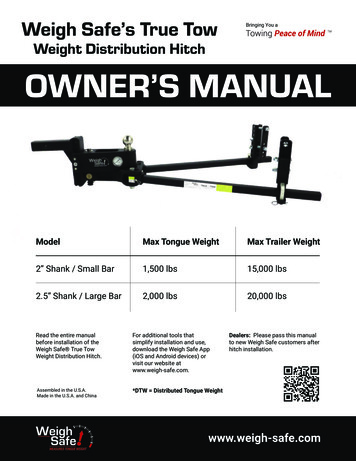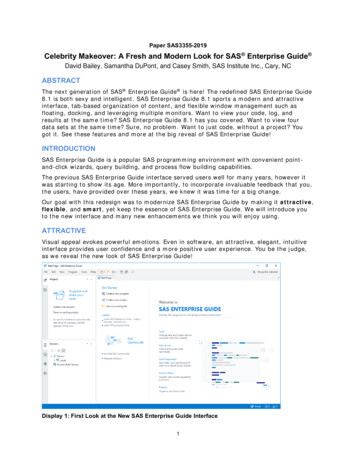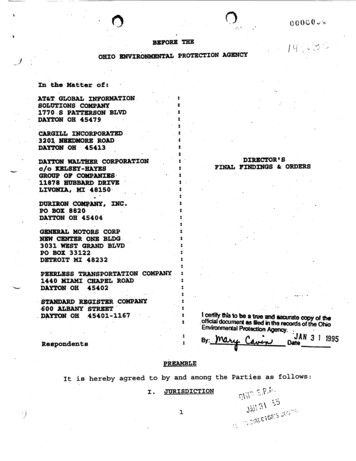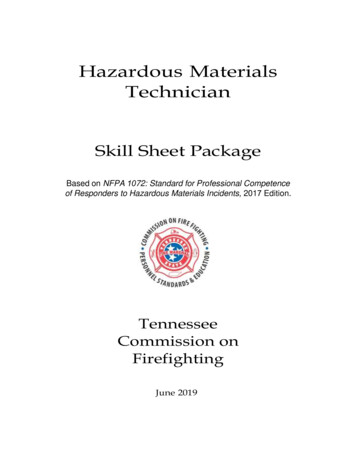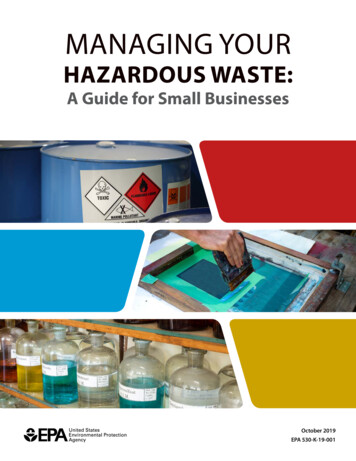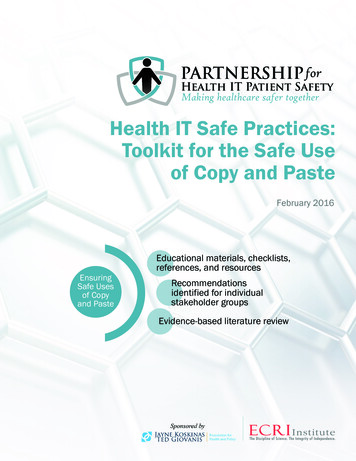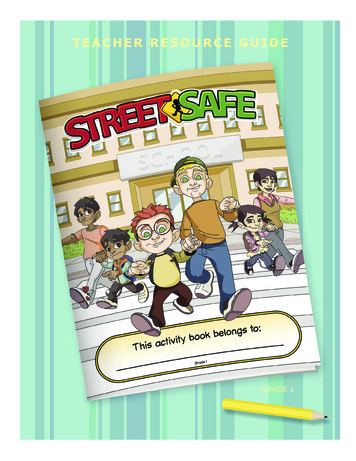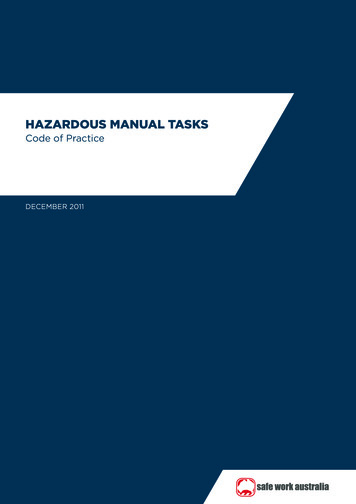
Transcription
HAZARDOUS MANUAL TASKSCode of PracticeDECEMBER 2011
Safe Work Australia is an Australian Government statutory agency established in 2009. Safe WorkAustralia consists of representatives of the Commonwealth, state and territory governments, theAustralian Council of Trade Unions, the Australian Chamber of Commerce and Industry and theAustralian Industry Group.Safe Work Australia works with the Commonwealth, state and territory governments to improvework health and safety and workers’ compensation arrangements. Safe Work Australia is a nationalpolicy body, not a regulator of work health and safety. The Commonwealth, states and territorieshave responsibility for regulating and enforcing work health and safety laws in their jurisdiction.ISBN 978-0-642-33307-0 [PDF]ISBN 978-0-642-33308-7 [RTF]Creative CommonsExcept for the logos of Safe Work Australia, SafeWork SA, Workplace Standards Tasmania,WorkSafe WA, Workplace Health and Safety QLD, NT WorkSafe, WorkCover NSW, Comcare andWorkSafe ACT, this copyright work is licensed under a Creative CommonsAttribution-Noncommercial 3.0 Australia licence. To view a copy of this licence, /au/In essence, you are free to copy, communicate and adapt the work for non commercial purposes,as long as you attribute the work to Safe Work Australia and abide by the other licence terms.Contact informationSafe Work AustraliaPhone: 61 2 6121 5317Email: info@safeworkaustralia.gov.auWebsite: www.safeworkaustralia.gov.auWORKSAFEWestern Australia
TABLE OF CONTENTSFOREWORD25.REVIEWING CONTROL MEASURES351.INTRODUCTION36.1.1What is a musculoskeletal disorder (MSD)?3ROLE OF DESIGNERS, MANUFACTURERS,IMPORTERS AND SUPPLIERS361.2What is a hazardous manual task?4Designers361.3Who has health and safety dutiesin relation to hazardous manual tasks?1.42.2.1What is required to manage the risk ofmusculoskeletal disorders?456.16.2 Manufacturers, importers and suppliers37APPENDIX A – THE RISK MANAGEMENTPROCESS FOR MANUAL TASKS39APPENDIX B – HAZARDOUS MANUALTASK IDENTIFICATION WORKSHEET40IDENTIFYING HAZARDOUSMANUAL TASKS7APPENDIX C – DISCOMFORT SURVEY41How to identify hazardous manual tasks7APPENDIX D – RISK ASSESSMENTWORKSHEET422.2 Characteristics of Hazardous Manual Tasks83.ASSESSING THE RISKS12APPENDIX E – CONTROLLINGMSD RISKS THROUGH DESIGN483.1When should a risk assessmentbe conducted?12APPENDIX F – REFERENCES FORFURTHER RISK ASSESSMENT METHODS493.2 How to do a risk assessmentfor hazardous manual tasks123.3 What are the risk factors?133.4 What are the sources of the risk?164.CONTROLLING THE RISKS204.1The hierarchy of control204.2 Purchasing to eliminate or minimise risks214.3 Changing the design or layoutof work areas214.4 Changing the nature, size,weight or number of items handled234.5 Using mechanical aids254.6 Handling people and animals284.7 Changing the system of work294.8 Changing the work environment304.9 Using administrative control measures324.10 Implementing control measures34CODE OF PRACTICE HAZARDOUS MANUAL TASKS1
FOREWORDThis Code of Practice on how to identify hazardous manual tasks and control the risks ofworkers being affected by musculoskeletal disorders is an approved code of practice undersection 274 of the Work Health and Safety Act.An approved code of practice is a practical guide to achieving the standards of health, safetyand welfare required under the Work Health and Safety Act (the WHS Act) and the WorkHealth and Safety Regulations (the Regulations).A code of practice applies to anyone who has a duty of care in the circumstancesdescribed in the code. In most cases, following an approved code of practice would achievecompliance with the health and safety duties in the WHS Act, in relation to the subjectmatter of the code. Like regulations, codes of practice deal with particular issues and do notcover all hazards or risks that may arise. The health and safety duties require duty holdersto consider all risks associated with work, not only those for which regulations and codes ofpractice exist.Codes of practice are admissible in court proceedings under the WHS Act and Regulations.Courts may regard a code of practice as evidence of what is known about a hazard, riskor control and may rely on the code in determining what is reasonably practicable in thecircumstances to which the code relates.Compliance with the WHS Act and Regulations may be achieved by following anothermethod, such as a technical or an industry standard, if it provides an equivalent or higherstandard of work health and safety than the code.An inspector may refer to an approved code of practice when issuing an improvement orprohibition notice.This Code of Practice has been developed by Safe Work Australia as a model code ofpractice under the Council of Australian Governments’ Inter-Governmental Agreement forRegulatory and Operational Reform in Occupational Health and Safety for adoption by theCommonwealth, state and territory governments.A draft of this Code of Practice was released for public consultation on 7 December 2010and was endorsed by the Workplace Relations Ministers Council on 10 August 2011.SCOPE AND APPLICATIONThis Code provides practical guidance to persons conducting a business or undertaking onhow to manage the risk of musculoskeletal disorders arising from hazardous manual tasksin the workplace. It applies to all types of work and all workplaces where manual tasks arecarried out.This Code explains how to identify hazardous manual tasks, assess the risks ofmusculoskeletal disorders and eliminate or minimise those risks. This guidance is alsorelevant for designers, manufacturers, importers or suppliers of equipment, materials andtools used for work, as well as designers of workplaces where manual tasks are carried out.HOW TO USE THIS CODE OF PRACTICEIn providing guidance, the word ‘should’ is used in this Code to indicate a recommendedcourse of action, while ‘may’ is used to indicate an optional course of action.This Code also includes various references to provisions of the WHS Act and Regulationswhich set out the legal requirements. These references are not exhaustive. The words ‘must’,‘requires’ or ‘mandatory’ indicate that a legal requirement exists and must be complied with.2CODE OF PRACTICE HAZARDOUS MANUAL TASKS
1. INTRODUCTIONMost jobs involve carrying out some type of manual task using the body to move or hold anobject, people or animals. Manual tasks cover a wide range of activities including stackingshelves, working on a conveyor line and entering data into a computer.Some manual tasks are hazardous and may cause musculoskeletal disorders. These are themost common workplace injuries across Australia.1.1What is a musculoskeletal disorder (MSD)?A musculoskeletal disorder, as defined in the WHS Regulations, means an injury to, or adisease of, the musculoskeletal system, whether occurring suddenly or over time. It doesnot include an injury caused by crushing, entrapment (such as fractures and dislocations) orcutting resulting from the mechanical operation of plant.MSDs may include conditions such as: sprains and strains of muscles, ligaments and tendons back injuries, including damage to the muscles, tendons, ligaments, spinal discs, nerves,joints and bones joint and bone injuries or degeneration, including injuries to the shoulder, elbow, wrist,hip, knee, ankle, hands and feet nerve injuries or compression (e.g. carpal tunnel syndrome) muscular and vascular disorders as a result of hand-arm vibration soft tissue hernias chronic pain.MSDs occur in two ways: gradual wear and tear to joints, ligaments, muscles and inter-vertebral discs caused byrepeated or continuous use of the same body parts, including static body positions sudden damage caused by strenuous activity, or unexpected movements such as whenloads being handled move or change position suddenly.Injuries can also occur due to a combination of these mechanisms, for example, bodytissue that has been weakened by cumulative damage may be vulnerable to sudden injuryby lower forces.CODE OF PRACTICE HAZARDOUS MANUAL TASKS3
1. INTRODUCTION1.2What is a hazardous manual task?A hazardous manual task, as defined in the WHS Regulations, means a task that requires aperson to lift, lower, push, pull, carry or otherwise move, hold or restrain any person, animalor thing involving one or more of the following: repetitive or sustained force high or sudden force repetitive movement sustained or awkward posture exposure to vibration.These factors (known as characteristics of a hazardous manual task) directly stress the bodyand can lead to injury.1.3Who has health and safety duties in relationto hazardous manual tasks?A person conducting a business or undertaking has the primary duty to ensure, so far as isreasonably practicable, that workers and other persons are not exposed to health and safetyrisks arising from the business or undertaking.The WHS Regulations include specific obligations for persons conducting a business orundertaking to manage the risk of a musculoskeletal disorder associated with a hazardousmanual task.Designers, manufacturers, importers and suppliers of plant and structures that are likely tobe handled or used during or as part of a manual task have an important role in eliminatingor minimising the risks of MSDs, which are often associated with the poor design and layoutof work areas as well as the design of equipment, tools, packaging and materials. Theymust ensure, so far as is reasonably practicable, that the plant or structure they design,manufacture, import or supply is without risks to health and safety (see Chapter 6 of thisCode for further guidance).Officers, such as company directors, have a duty to exercise due diligence to ensure thatthe business or undertaking complies with the WHS Act and Regulations. This includestaking reasonable steps to ensure that the business or undertaking has and uses appropriateresources and processes to eliminate or minimise risks that arise from hazardous manualtasks.Workers have a duty to take reasonable care for their own health and safety and that theydo not adversely affect the health and safety of other persons. Workers must comply withany reasonable instruction and cooperate with any reasonable policy or procedure relatingto health and safety at the workplace.4CODE OF PRACTICE HAZARDOUS MANUAL TASKS
1. INTRODUCTIONWhat is required to manage the riskof musculoskeletal disorders?1.4A person conducting a business or undertaking must manage risks to health and safetyrelating to a musculoskeletal disorder associated with a hazardous manual task.Regulation 60In order to manage risk under the WHS Regulations, a duty holder must:Regulation 34-38 identify reasonably foreseeable hazards that could give rise to the risk eliminate the risk so far as is reasonably practicable if it is not reasonably practicable to eliminate the risk – minimise the risk so far as isreasonably practicable by implementing control measures in accordance with thehierarchy of control maintain the implemented control measure so that it remains effective review, and if necessary revise, risk control measures so as to maintain, so far as isreasonably practicable, a work environment that is without risks to health and safety.This Code provides guidance on how to manage the risks associated with those manual tasksthat have the potential to cause MSDs by following a systematic process that involves: identifying manual tasks that are hazardous if necessary, assessing the risks of MSDs associated with the hazardous manual task implementing suitable risk control measures reviewing the effectiveness of control measures.A summary of this process in relation to manual tasks is at Appendix A. Guidance on thegeneral risk management process is available in the Code of Practice: How to Manage WorkHealth and Safety Risks.CONSULTING YOUR WORKERSSection 47The person conducting the business or undertaking must consult, so far as is reasonablypracticable, with workers who carry out work for the business or undertaking who are(or are likely to be) directly affected by a work health and safety matter.Section 48If the workers are represented by a health and safety representative, the consultationmust involve that representative.Consultation involves sharing of information, giving workers a reasonable opportunity toexpress views and taking those views into account before making decisions on health andsafety matters.Consultation with workers and their health and safety representatives is necessary ateach step of the risk management process. Your workers know which tools and activitiescontribute to their discomfort and may have practical suggestions or potential solutions.CODE OF PRACTICE HAZARDOUS MANUAL TASKS5
1. INTRODUCTIONIt is important to consult your workers as early as possible when planning to: introduce new tasks or change existing tasks select new equipment refurbish, renovate or redesign existing workplaces carry out work in new environments.You should also encourage your workers to report problems with manual tasks and signs ofdiscomfort immediately so that risks can be managed before an injury occurs.CONSULTING, CO-OPERATING AND CO-ORDINATING ACTIVITIES WITH OTHER DUTYHOLDERSSection 46If more than one person has a duty in relation to the same matter, each person withthe duty must, so far as is reasonably practicable, consult, co-operate and co-ordinateactivities with all other persons who have a work health or safety duty in relation tothe same matter.Sometimes you may share responsibility for a health and safety matter with other businessoperators who are involved in the same activities or who share the same workplace. In thesesituations, you must exchange information to find out who is doing what and work togetherin a co-operative and co-ordinated way so that all risks are eliminated or minimised so far asis reasonably practicable.For example, if a supplier visits your workplace to deliver goods, you should discuss withthe supplier how the goods will be handled at your workplace, whether there are anyenvironmental or other factors that may increase the risk (for example, using a flight of stairswhile handling large boxes) and what you each will do to control any risk of injury.Further guidance is available in the Code of Practice: Work Health and Safety Consultation,Co-operation and Co-ordination.6CODE OF PRACTICE HAZARDOUS MANUAL TASKS
2. IDENTIFYING HAZARDOUSMANUAL TASKSThe first step in managing risks from carrying out manual tasks is to identify those tasks thathave the potential to cause MSDs. Hazards that arise from manual tasks generally involveinteraction between a worker and: the work tasks and how they are performed the tools, equipment and objects handled the physical work environment.2.1How to identify hazardous manual tasksCONSULT YOUR WORKERSWorkers who perform manual tasks can provide valuable information about discomfort,muscular aches and pains that can signal potential hazards. For example, you could askworkers to identify tasks that: are difficult to do (or appear harder than they should be) are very tiring (muscle fatigue reduces work capacity) are awkward or dangerous (for example, difficulty controlling loads) cause discomfort.A discomfort survey that may be used is at Appendix B.REVIEW AVAILABLE INFORMATIONRecords of workplace injuries and incidents, inspection reports and any workerscompensation claims made for MSDs should be reviewed to help identify which manual tasksmay cause harm. However, not all hazardous manual tasks will be associated with reportedincidents, therefore it is important to gather additional information.Information and advice about hazardous manual tasks and risks relevant to particularindustries and work activities is available from regulators, industry associations, unions,technical specialists and safety consultants.LOOK FOR TRENDSYou may be able to identify trends or common problems from the information you collect.Trends may show that certain tasks have more characteristics that make them hazardousor that some characteristics are more common in certain jobs. Trends may also show thatworkers in a particular location are exposed to more hazardous manual tasks than in otherareas and this could indicate a problem with the design and layout of that work area or theway work is carried out there.These trends may help in deciding which manual tasks should be addressed as a priority.OBSERVE MANUAL TASKSHazardous manual tasks can also be identified by looking at how people actually work andfocussing on their postures and movements. A manual task is hazardous if it involves any ofthe following characteristics (described in Section 2.2): repetitive or sustained force high or sudden force repetitive movementCODE OF PRACTICE HAZARDOUS MANUAL TASKS7
2. IDENTIFYING HAZARDOUS MANUAL TASKS sustained and/or awkward posture exposure to vibration.Things to look out for include: any changes that have resulted in new manual tasks or a changed environment tasks involving tools, machinery or equipment that do not work properly or are difficultto use, and if workers have made improvisations to tasks to avoid discomfort (such as stacking matsor flattened cartons to stand on).The hazard identification worksheet in Appendix C may be used to record your findings.2.2Characteristics of Hazardous Manual TasksFORCE IS THE AMOUNT OF MUSCULAR EFFORT REQUIRED TO PERFORM A MOVEMENT OR TASK.FORCEFUL MUSCULAR EXERTIONS OVERLOAD MUSCLES, TENDONS, JOINTS AND DISCS AND AREASSOCIATED WITH MOST MSDS.Repetitive force- using forcerepeatedly overa period of timeto move orsupport anobjectSustained force- occurs whenforce is appliedcontinually overa period of time.8Examples of repetitive force include: lifting and stacking goods ontoa pallet gripping and handling brickswhen bricklaying (Figure 1) repetitively pressing componentswith the thumbs or other part ofthe hand to assemble an item prolonged application oftherapeutic massage treatments removing splinting material frompatients using shears.FIGURE 1Example of sustained force include: pushing or pulling a trolleyaround hospital wards (Figure 2) holding down a trigger to operatea power tool supporting a plaster sheet whilefixing it to a ceiling carrying objects over longdistances supporting, positioning orstabilising a patient’s limbduring surgery or when applyingsplinting or casting materialCODE OF PRACTICE HAZARDOUS MANUAL TASKSFIGURE 2
2. IDENTIFYING HAZARDOUS MANUAL TASKSHigh force – may beexerted by the back,arm or leg musclesor by the hands andfingers.Examples of high force include: Lifting, lowering or carrying aheavy object Lifting, lowering or carryingan object that cannot bepositioned close to the body pushing or pulling an objectthat is hard to move or stop restraining a person or animal.(Figure 3)High force occursin any tasks that: a workerdescribes asvery demandingphysically a worker needshelp to dobecause of theeffort it requires require astronger personor two personsto dothe task.FIGURE 3Examples of high force using thehands and fingers include: using a finger-grip, a pinchgrip or an open-handed grip tohandle a heavy or large load operating hand toolswith tight squeeze grips(Figure 4) gripping small instrumentswith high force, for example, adental hygienist cleaning teeth.FIGURE 4Sudden force –jerky or unexpectedmovements whilehandling an item orload are particularlyhazardous becausethe body mustsuddenly adapt tothe changing force.Tasks where forceis applied suddenlyand with speedalso generates highforce.Examples of sudden force include: impact recoil of a largenail gun throwing or catching objects cutting reinforcement steelwith large bolt cutters carrying an unbalancedor unstable load such asbagged stock feed pellets thatsuddenly moves(Figure 5) handling frightenedor resistant animals handling patients whosuddenly resist or no longerassist during the handlingprocedure.CODE OF PRACTICE HAZARDOUS MANUAL TASKSFIGURE 59
2. IDENTIFYING HAZARDOUS MANUAL TASKSMOVEMENTRepetitivemovement – usingthe same parts ofthe body to repeatsimilar movementsover a periodof time.Examples of repetitivemovement include: painting lifting goods from a conveyorbelt and packing them ina carton typing and otherkeyboard tasks (Figure 6) repeatedly reaching for andassembling components inelectronics manufacturing FIGURE 6using a socket and ratchet orspanner to unscrew long bolts.POSTUREAN IDEAL POSTURE IS ONE WHERE THE TRUNK AND HEAD ARE UPRIGHT AND FORWARD FACING, THE ARMSARE BY THE SIDE OF THE BODY, THE FOREARMS ARE EITHER HANGING STRAIGHT OR AT RIGHT ANGLES TOTHE UPPER ARM, AND THE HAND IS IN THE HANDSHAKE POSITION.POSTURES THAT ARE BOTH AWKWARD AND SUSTAINED ARE PARTICULARLY HAZARDOUS.Sustained posture –where part of or thewhole body is keptin the same positionfor a prolongedperiod.Awkward posture –where any partof the body is in anuncomfortable orunnatural position,such as: 10postures thatare unbalancedor asymmetricalpostures thatrequire extremejoint angles orbending andtwisting.Examples of sustainedposture include: supporting plasterboardsheeting while it is nailed intoplace (Figure 7) continually standingwith weight mainly onone leg while operatinga power press with footpedal controls.FIGURE 7Examples of awkwardposture include: squatting while servicing plantor a vehicle working with arms overhead bending over a desk or table using a hand tool that causesthe wrist to be bent to the side kneeling while trowellingconcrete or laying carpet bending the neck or back tothe side to see around bulkyitems pushed on a trolley.(Figure 8)CODE OF PRACTICE HAZARDOUS MANUAL TASKSFIGURE 8
2. IDENTIFYING HAZARDOUS MANUAL TASKSVIBRATIONTHERE ARE TWO COMMON FORMS OF VIBRATION ACCORDING TO CONTACT POINTS BETWEENTHE BODY AND THE SOURCE:Whole body vibration occurswhen vibration is transmittedthrough the whole body,usually via a supportingsurface, such as a seat orthe floor in heavy vehicles ormachinery. This may result inlower back pain, degenerationof the lumbar vertebrae anddisc herniation.Examples of wholebody vibration include:Hand-arm vibration occurswhen vibration is transferredthrough a vibrating tool,steering wheel or controls inheavy machinery to the handand arm. This can disruptblood circulation in the handand forearm and damagenerves and tendons. Localisedvibration contributes to‘vibration-induced whitefinger’ and ‘carpal tunnelsyndrome’ through thegripping force needed to holdthe vibrating tools (the tighterthe grip, the more vibration isabsorbed) and the repetitiveshock loads of some tools.Examples of hand-armvibration include: operating mobile plantsuch as heavy earthmoving machinery driving a vehicle overrough terrain.(Figure 9) using impactwrenches, chainsaws,jackhammers, grinders,drills or vibratingcompacting plates(Figure 10-11) using needle guns inde-rusting metal.FIGURE 9FIGURE 10FIGURE 11CODE OF PRACTICE HAZARDOUS MANUAL TASKS11
3. ASSESSING THE RISKSA risk assessment involves examining the characteristics of the hazardous manual taskin more detail to assess whether the forces, movements and postures are undertakenin such a way that they give rise to the risk of MSDs.3.1When should a risk assessment be conducted?You should carry out a risk assessment for any manual tasks that you have identified as beinghazardous, unless the risk is well-known and you know how to control it. A risk assessmentcan help you determine: which postures, movements and forces of the task pose a risk where during the task they pose a risk why they are occurring what needs to be fixed.3.2How to do a risk assessment for hazardousmanual tasksIdentify who should participate in the risk assessment, for example those workers who dothe task or their health and safety representative, and management who have control overhow the task is done. Describe the task and area where the manual task is performed. Notewhich body parts are likely to be at risk of injury, then work through the assessment togetherto determine which risk factors pose a risk and why the risk exists.The whole task should be examined, although it may help to look at the task in stages toidentify all of the risk factors. For example, the task of putting stationery items away in astorage cabinet may involve the following steps: collecting boxes of stationery supplies from the delivery dock – handling boxes that arebulky may increase the risks associated with this task transporting stationery supplies to the storage area – using a trolley with poorlymaintained wheels may increase effort unpacking boxes of stationery supplies – unpacking boxes from the floor may increaseawkward postures placing supplies on storage shelves – shelving heights that are too high or too low mayincrease awkward postures.Looking at each of the steps identifies the different sources of risk, which are the things thatshould be changed to control the risks.For some complex situations, expert or specialist advice may be useful when conductinga risk assessment. There are a range of risk assessment tools that may be used. Furtherinformation is in Appendix F.ASSESSING SIMILAR TASKSIf a number of your workers carry out very similar hazardous manual tasks, you may assessthese tasks together as a group instead of assessing each task individually. However, youshould only do a group risk assessment if all the tasks are sufficiently similar and do notexpose a worker to a different risk than if individual assessments were carried out.12CODE OF PRACTICE HAZARDOUS MANUAL TASKS
3. ASSESSING THE RISKS3.3What are the risk factors?Working through the following questions will assist in determining which postures,movements and forces of the task pose a risk. The Risk Assessment Worksheetat Appendix D may be used to record the findings.QUESTION 1: DOES THE TASK INVOLVE ANY OF THE FOLLOWING: repetitive movement? sustained or awkward postures? repetitive or sustained forces?As a general guideline, ‘repetitive’ means that a movement or force is performed more thantwice a minute and ‘sustained’ means a posture or force is held for more than 30 secondsat a time.Examples of postures and movements that pose a risk if they are repetitive or sustained are:FIGURE 12 Bendingthe head forwards orsideways more than20 degrees20 20 FIGURE 15 Twistingthe neck more than20 degreesFIGURE 13 Bendingthe back forwards orsideways more than20 degreesFIGURE 14 Bendingthe back or headbackwards more than 5degrees or looking up20 FIGURE 16 Twistingthe back more than20 degreesCODE OF PRACTICE HAZARDOUS MANUAL TASKSFIGURE 17 Working withone or both handsabove shoulder height13
3. ASSESSING THE RISKSFIGURE 18 Reachingforward or sidewaysmore than 30cmfrom the bodyFIGURE 21 Standing withmost of the body’sweight on one legFIGURE 24 Squatting,kneeling, crawling, lying,semi-lying or jumping14FIGURE 19 Reachingforward or sidewaysmore than 30cm fromthe bodyFIGURE 22 Twisting, turning,grabbing, picking orwringing actions with thefingers, hands or arms thatincludes excessive bendingof the wristFIGURE 25 Very fastmovements, for examplepacking bottles from a fastmoving process lineCODE OF PRACTICE HAZARDOUS MANUAL TASKSFIGURE 20 Reachingbehind the bodyFIGURE 23 Working withthe fingers close togetheror wide apart
3. ASSESSING THE RISKSThe risk increases as the degree of bending and twisting increases. The risk is greatest whenthe postures and movements are extreme, that is, toward the end of the movement range,and when they feel uncomfortable for the worker.QUESTION 2: DOES THE TASK INVOLVE LONG DURATION?If you have assessed a task as involving postures, movements or forces that are alsorepetitive (more than two per minute) and/or sustained (held for more than 30 seconds),you should determine the duration of the task.The duration of the task is how long the task is carried out over a whole shift or continually atany time during a shift. Tasks that continue over a long period or are repeated over the workday increase the risk of injury.As a general guideline, long duration means the task is done for more than a total of 2 hoursover a whole shift or continuously for more than 30 minutes at a time.Keep in mind that workers may use the same parts of the body to repeat similar movementswhen carrying out various tasks that are similar in nature over time.QUESTION 3: DOES THE TASK INVOLVE HIGH OR SUDDEN FORCE?High forces can cause MSDs even if they are not repetitive or sustained. This means thatany task involving high force may be a risk, even if it is only done occasionally or for shortperiods. The longer and more often force is applied and the higher the force, the greater therisk.The risk in tasks involving high force is related to: the intensity of the force needed - forceful muscular exertions place high stress on themuscles, tendons, joints, ligaments and vertebral discs. the speed involved - fast movements (particularly if repeated) can injure muscles,tendons and ligaments. The rapid or sudden speed changes caused by sudden orunexpected movements are high risk. whether the force is jerky or sudden - forces suddenly applied or stopped can overloadthe muscles, tendons, joints, ligaments and vertebral discs. This can occur when throwingor catching loads, or when the load or item worked on moves unexpectedly (for example,when pulling up a fence post that suddenly comes free, or assisting and holding awalking patient who suddenly falls).High and sudden forces are commonly associated with the handling of live persons oranimals and loads that are unstable, unbalanced or difficult to hold.QUESTION 4: DOES THE TASK INVOLVE VIBRATION?Prolonged exposure to whole-body or hand-arm vibration increases the risk of MSDs andother health problems. The degree of risk increases as the duration of exposure increasesand when the
CODE OF PRACTICE HAZARDOUS MANUAL TASKS 5 1.4 What is required to manage the risk of musculoskeletal disorders? A person conducting a business or undertaking must manage risks to health and safety relating to a musculoskeletal disorder associated with a hazardous manual task.
